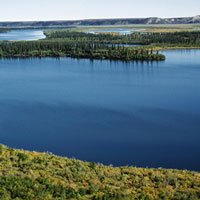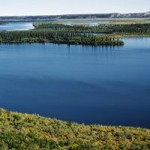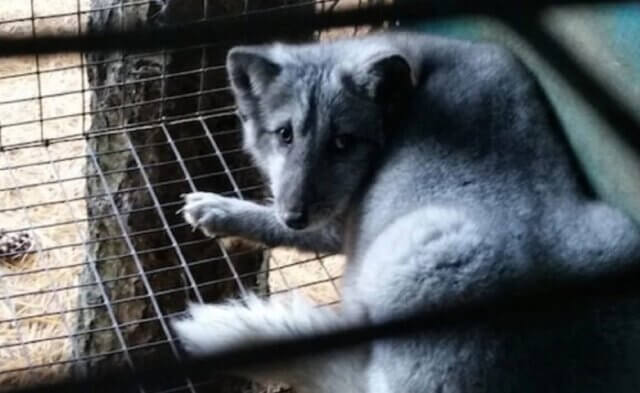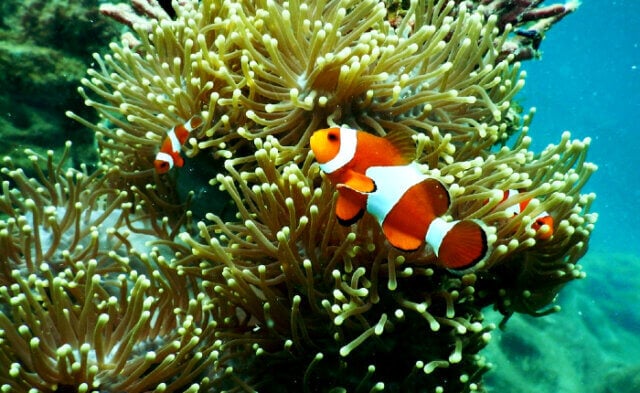PETA’s 2014 Sexiest Vegan Over 50 winner Ed Ozols’ beautifully written article about the environment and being vegan may inspire you to go vegan, if you’re not already … and enter this year’s contest!
Tonight’s rain is falling lightly on the forest floor, and the Earth responds by giving up her spicy scents. I’ve breathed in these wonderful aromas a thousand times, never wondering if it would ever end, if the rains might stop, or if death would come to these boreal forests. But yes, it might. And water, or rather the lack thereof, is shaping our future all over the Earth right now.
This evening, 14 million people will come home from a day of hard labor in the fields of the Amazon basin. They’ll find that just as there was little for their animals to drink, their own spigots are once again dry. These fields were not here a generation ago, and soon perhaps, they’ll disappear back into the dying rain forests, ghosts in the land that contains one-fifth of the world’s freshwater.
Under the early Pliocene sun, 6 million years before vast glaciers swarmed southward, water started to accumulate in an immense underground lake. Nature had worked for eons to create the largest and purest aquifer on Earth. For years, the Ogallala Aquifer lay beneath 250,000 square miles of Midwestern America, safely hidden from thundering bison and armies of adventurers and mercenaries who came and went. It wasn’t until the Dust Bowl days blew away that it was discovered by humans. Its waters then turned the ochre prairie into a green Eden of grasslands and livestock.
But it was oil that caused its undoing. The new diesel-fueled motors pumped 1,000 times more water than the old wind-powered ones. Food production exploded, and animal slaughter became an industrial enterprise. After its first 50 years of exploitation, only one-third of the water in the aquifer remained. We had squandered most of it to grow corn for the animals we ate. Scientists now believe that there’s enough water left to last us another few decades. But what will happen then?
The Colorado River, whose thundering waters once nourished all the life along its path, no longer even reaches its end at the Sea of Cortez. Emasculated for all to see, it has been sucked dry by irrigation and preposterously sited desert cities parched with ever-growing thirst. Yet the cities expand even further, and even more animals must be fed.
The West Coast of the United States has gone through eras of catastrophic drought, turning its impossibly fertile valleys into desert for periods as long as 1,000 years. The Central Valley of California alone, which contains less than 1 percent of America’s farmland, grows one-third of our produce. There are 230 different crops, including 95 percent of the world’s almonds and 95 percent of its canned tomatoes. Just two companies harvest 85 percent of our carrots. Don’t even ask about artichokes. And now, the worst drought in more than 100 years has begun. More groundwater is being pumped here for irrigation than anywhere else in America. But water is finite and will run out—and then what?
As increasing pressure is put on Earth’s water resources, nature has been unable to replenish them. And no one can make more of them. If you want to know what some of our next political battles and wars will be about, think about water. As freshwater becomes scarcer, its price will rise, probably dramatically—it’s already more valuable than crude oil. That’s why shrewd billionaires have been buying up land over underground aquifers so that they can eventually sell you “their” water at prices that would make a sultan blush. It’s the same reason why large corporations are selling you water in bottles—the same water you get from your tap, at a 2,000 percent markup.
Wait! Why do we need so much water? It’s because of what we choose to eat. In order to produce 1 pound of potatoes, 60 gallons of water are required. In order to produce 1 pound of wheat, we need to use 108 gallons of water. In contrast, producing a single pound of meat requires 2,500 gallons of water (or as Newsweek once put it, “The water that goes into a 1,000 pound steer would float a destroyer”). The 2,500 gallon figure is disputed, though. One eminent agricultural scientist puts the figure at 12,000 gallons per pound of beef. Whichever figure one accepts, it should be clear that raising an animal for food is much more water intensive than growing a vegetable.
Maintaining our current meat-eating preferences will have an enormous effect on the diminishing supply of freshwater. In the late 1930s, when widespread exploitation of the Ogallala began, yearly per capita beef consumption had remained steady for decades at less than 100 pounds per person. As a result of increased irrigation, yearly consumption had reached 180 pounds per person by 2008. Although this number had dropped to 165 pounds per person in 2012, the increased consumption of poultry more than made up the difference, as chicken is what’s for dinner in more households each night.
So when water becomes recherché in the coming decades, meat will have to increase in price at a much greater rate than plant-based foods because of its colossal water requirements. The cost of 1 pound of animal flesh must include the cost of the animals’ plant food as well. In order to fatten animals quickly for slaughter, we feed them mostly corn (which requires more water to grow than most plants), instead of allowing them to graze on grass or, in the case of poultry, on seeds and bugs. The cost of alfalfa hay has risen by 200 percent in the past three years alone. As prices continue to escalate, meat may become a food that’s mostly affordable to just the top 1 percent.
The remaining 99 percent of families, already squeezed by our new economic realities, will have no choice but to cut back on animal fat and protein and make up the difference with plant-based foods. Simple fresh vegetables would be best. But corporate ranchers won’t take this lying down. Inadvertently, they’ll push us toward vegan eating, coming up with increasingly creative meat-like concoctions. Around the time that your grandchildren are grown, a Big Mac may have become less of a meaty burger and more of a fleshless doppelgänger reconstituted with mostly plant-based or mycoprotein fillers, topped with mounds of salad fixin’s. Is this beginning to sound like a veggie burger to you?
Written by Ed Ozols, PETA’s 2014 Sexiest Vegan Over 50 contest winner. Ed is an architect and sometime photographer, musician, writer and vegan chef.






